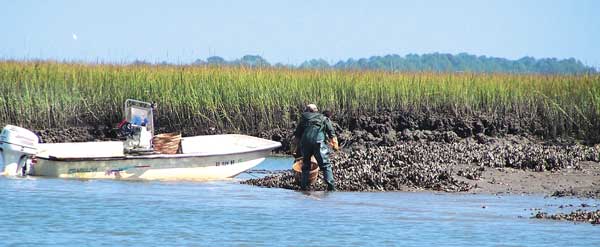
Nothing restores your balance of “brownie points” with the spouse like a Valentine’s Day oyster roast. Here’s how to go get them yourself.
Well, deer season ended a month ago, and turkey season is still a long ways away.
What few “brownie points” you had after deer season were spent on that duck-hunting trip or the redfish outing.
What’s a sportsman to do?
How ’bout throwing a Valentine’s Day oyster roast? There’s nothing like a big social event in honor of your valentine to get you back in the good graces of your spouse.
“Unlike most hunting and fishing activities, it’s hard to get skunked when you’re after oysters,” quipped Andy Jennings, coordinator for the S.C. Department of Natural Resources’ oyster shell recycling program. “The only deciding factor is whether or not the tide will go out.”
Jennings works at the marine lab at Ft. Johnson in Charleston. Even after working on the oyster program all year, he looks forward to the open season to collect a few of his own.
“If you’re not sure exactly where you are, the best place to start is with a map of the area from the South Carolina Public Shellfish Grounds website,” he said.
Shellfish grounds are divided into several usage categories: state grounds, public grounds, commercial-permitted grounds, and closed-to-harvest areas. They are marked, but signs can be missing or misunderstood. If you have a map and are still not sure whether you’re on a commercially-permitted or closed ground, it’s best to check with the Marine Resources Division to make sure you’re both safe and legal.
Oyster Harvesting
Most any small, flat-bottomed boat with a reliable motor is suitable for oystering.
Jennings likes to start at least an hour before low tide, which gives him a head start on moving around an oyster bed, looking for the most choice oysters.
He’ll motor to the sand bar closest to the bed and secure his boat while getting his equipment ready. Clad in an old pair of leather boots, Jennings is equipped to pick his way around the bed looking for specific clusters to harvest. A good cluster makes oysters easier to steam. Ideally, you’re looking for groups of 3- to 5-inch oysters with enough base to hold the cluster out of the water when steaming.
“Look for a long, thick oyster with white lips,” he said. “The white edges around the open end of the oyster show that it’s a healthy oyster that has good growth.”
A good oyster will be at least 3 to 3 ½ inches long, and the better ones, called “blades” in the oyster community, are 4 to 5 inches long. Some oysters will stunt and only get to be 1 to 2 inches long. These oysters either grew too close together or were not in an area that contained enough nutrients. They won’t be good to eat.
Jennings has seen a trend over the past 10 years of better oysters growing closer to the grassline in the marsh. In days gone by, better oysters were almost always flat on the bottom.
“It could be just a growth-cycle thing, or it could be attributed to recent droughts, increased boat wakes or any number of other reasons — we’re really not sure why,” he said.
Regardless of where you start on an oyster bed, it’s important to protect yourself with boots that sharp oyster rakes can’t cut through and a good set of heavy gloves. Jennings said leather gloves work fine, but some of the newer, heavy-rubber gloves favored by commercial crabbers work even better. He rounds out his arsenal with an old jacket that he doesn’t mind getting wet and muddy.
“The jacket is necessary, because you tend to get wet harvesting oysters, and it often gets cold down in the marsh.”
Jennings uses plastic 5-gallon buckets both to hold and measure his catch. He prefers a 5-gallon bucket over the standard bushel basket because he can fill one bucket and leave it in place while he starts filling the other. A 5-gallon bucket is equal to a half a bushel, so four full buckets is a daily harvest of oysters limit for one person.
Leaving buckets where he fills them cuts out toting a nearly full bushel basket through the bed or making multiple trips back to the basket — a practice that can unnecessarily damage other oysters in the bed. Buckets can be collected as the tide comes back up; the harvester can float his boat into the bed and collect them.
Veteran oysterers work the beds without tools, using gloved hands to pick and cull oysters. The majority prefer to use some type of tool to work the shells apart.
“The best tool gives you a way to pry the shells apart — like a claw hammer, crow bar or one of those flat wonder bars” Jennings said.
Selecting oysters to harvest requires some conservation tactics. As mentioned, excessive foot traffic can damage or kill young oysters. Watch your steps and pick your path. A good cluster may contain a dozen or more oysters, but only half may be worth taking. This requires a practice known as “culling in place.”
Pick up the entire cluster and separate the harvestable shells, then set the unused cluster back in place. Dropping the unused cluster upside down or tossing it aside can smother the smaller oysters in the mud. Try to piece the unused shells back in place with the rakes facing up.
It helps to think of culling oysters as picking grapes or strawberries. You wouldn’t rip up the plant by the root to get to the fruit. Select the fruit and leave the vine to produce again.
Cooking your catch
With two bushels of muddy oysters back at the dock, it’s time to get them ready for the dinner table. That’s a specialty of Robert Barber, a friend of Jennings. Barber lives on Bowen’s Island, a 14-acre island located between James Island and Folly Beach. He is also the owner of Charleston’s most famous off-the-beaten- path restaurant, Bowen’s Island Restaurant.
“We wash down all of our oysters first with a pump that draws saltwater right out of the river,” Barber said. “Lacking that, I guess you could use a bucket to rinse them with saltwater — at least to get the mud off. Then you have several options of what to do with them.”
The most popular methods to prepare oysters are roasting or steaming — different techniques with the same result. Roasted oysters are placed on a hot surface. Steamed oysters are placed in a large pot with a few inches of water in the bottom. More modern “steaming baskets” makes steaming a much easier affair.
“Back in the old days, people used to use an old car hood and lay it on the fire,” Barber said. “Nowadays, a lot of folks put a flat pan or metal sheet on the grill, lay the oysters out on it and cover them with a wet croaker (burlap) sack.”
Just like steak, some people like their oysters rare, and some like them well-done. Barber likes his oysters, if they’re cooked at all, to be roasted until just a few of the shells pop open. This means the rest of the unopened shells will be loose, and the oyster juice inside the shell will be hot — creating moist and full-flavored oysters.
The job is not done, however. Armed with an old rag or cotton glove and a thick-bladed oyster knife, Barber inserts the blade into the opened shells and twists them open from the front. Closed shells are best opened by prying the two shells apart, inserting the point of the blade between the shells at the joint and using a twisting motion of the wrist.
The prized meat is then unceremoniously scraped from the shell with the knife. Typically a messy affair, oyster roasts are often better staged outside — or at least on a covered patio or deck.
The final ingredients are some saltine crackers, your choice of beverage and Barber’s homemade cocktail sauce — the main ingredients being ketchup, horseradish, vinegar, sugar and a dose of Tabasco sauce. No wonder they’re considered “Nature’s Aphrodisiac.”
“Some folks may be squeamish about eating oysters for the first time or eating them raw anytime,” Barber said. “I can say without a doubt that South Carolina oysters, so long as they are harvested from a DHEC approved bed, are the safest and best-tasting oysters anywhere in the world.”
The South Carolina Department of Health and Environmental Control keeps a close watch on oyster beds. Water samples are taken frequently, and if the water quality doesn’t measure up, beds are closed. Since run-off is a major cause of oyster-bed pollution, beds have even been closed after a heavy rain that creates a large amount of run-off into the estuary.
Being filter feeders, any form of pollutant in the water soon finds it’s way into the oyster, but it is processed quickly, so beds are often only temporarily closed and may be reopened in just a few days by DHEC after the water clears.
The map series offered by the MRD will list beds that are closed by DHEC, and most permanent areas are marked with signs. If there is any doubt, a phone call to the MRD will clear up any confusion.
Recycle the shells
After the roast is over (and your brownie-point total is back in the black), make sure you renew the resource. Recycle your oyster shells.
“Raw green shucked oysters that are returned to the water within two or three days will still have seeds that will grow when replanted,” Jennings said, “but even oysters that have been roasted, steamed, baked, or cooked in any number of ways can still be recycled”.
South Carolina’s Oyster Recycling Program began in 2000. Nearly 55,000 bushels of oysters have been collected and replanted in the state’s waters. The program maintains 20 sites across four coastal counties: Charleston, Beaufort, Georgetown, and Colleton. By design, most of the collection sites are relatively close to major oystering grounds.
The general idea is to collect recycled shells and replant the substrate within a 12-month cycle. The most successful substrate for regrowing oysters is natural shell, but the MRD has been experimenting with different substances such as rock, concrete, and wood.
Replanting oyster beds is a matter of collecting shells on a barge and spreading them as thinly as possible over the target area. Over 25 percent of the shell deposited is recycled, but the department does buy substrate from out-of-state oyster factories.
Various factors determine which sites are selected for replanting: water quality, water flow, and the proximity of viable beds to reseed the new substrate. Free-swimming oyster larvae will readily reattach to recycled shell. The larvae’s choice of location is the most important decision an oyster will ever make. Oysters are not mobile by their own means.
Once a location is selected to replant, the MRD uses high- pressure water hoses to hose the recycled shell off the barge deck. The rushing water evenly distributes the shell on the marsh floor. From there, the cycle begins anew.

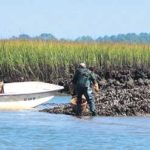

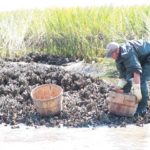
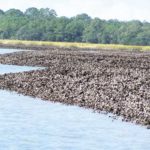
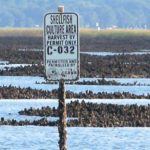



Be the first to comment